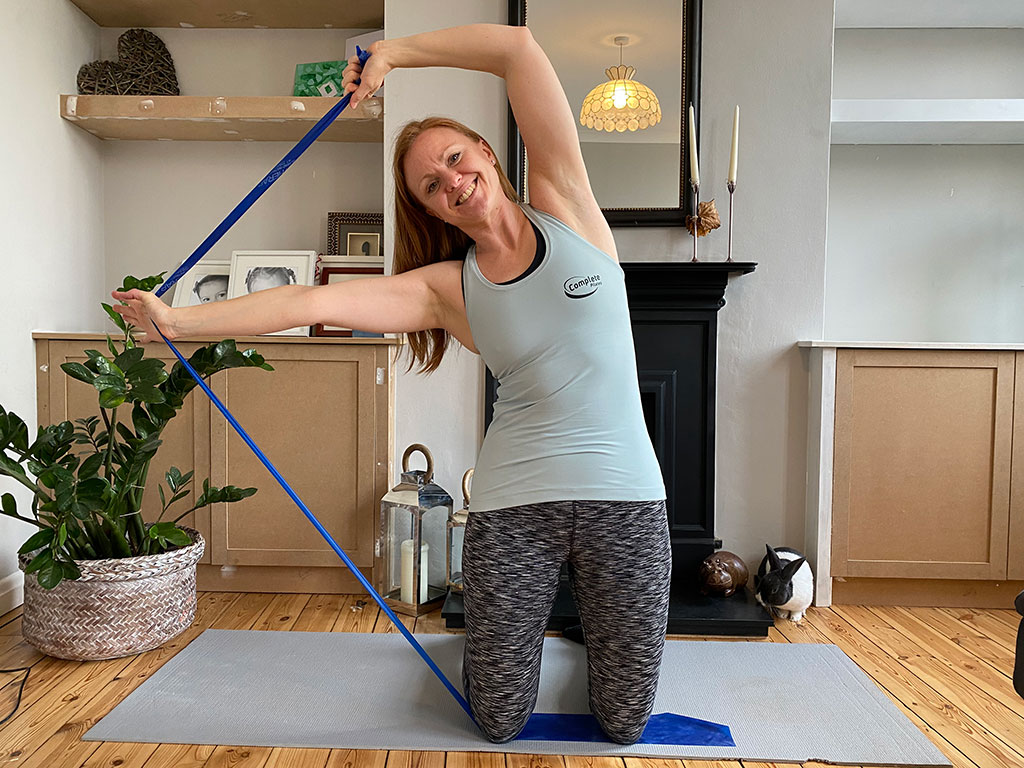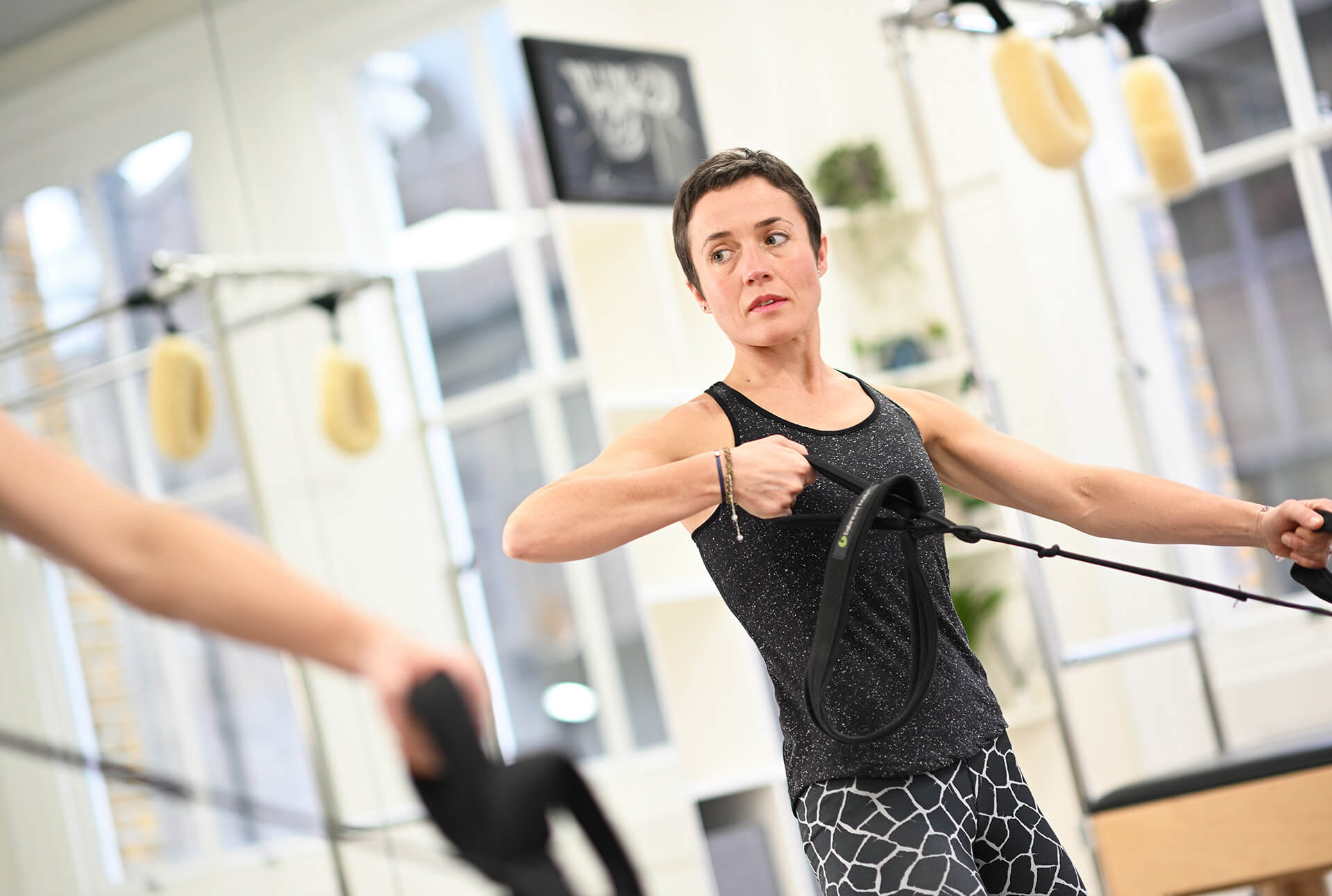Arm exercises at home are actually really easy to do and do not require the use of lots of heavy weights and bars.
In this blog we are going to show you 5 at home arm exercises which you can do using a band and your body weight, to help strengthen your arms, particularly your triceps.
Upper body strength is really important in day to day life as it helps with posture, lifting objects, opening heavy doors or simply lifting and playing with your children.
The stronger your arms and back are the easier these become!
All the exercises are suitable for anyone who doesn’t have acute shoulder pain.
If you do have an acute shoulder injury, please check with your treating physiotherapists, or us, before starting these.
All of these at home arm exercises can be made harder by increasing the resistance on the band or adding light weights which you can find around your house, including cans!
Arm muscle anatomy
Before getting started on your at home arm exercises, make sure you have an understanding of your arm muscle anatomy. Generally speaking, most people focus on their biceps and triceps when working out. By strengthening the muscles in your arm, you’ll help to maintain a balanced body, reduce the risk of injury, improve your posture, and enhance your workouts.
Biceps
There are a few muscles in the front of your upper arm, the most well known being your biceps.
Your biceps sits at the front of your upper arm between your elbow and shoulder and is responsible for bending (flexing) your elbow and supinating the forearm, or turning your palm up. It has two different heads, a long and short head.
Part of your biceps actually comes from your shoulder blade and then attaches onto the forearm. It works alongside two other muscles in your forearms including coracobrachialis and brachialis.
Biceps is not actually the strongest flexor but works alongside brachialis to support and stabilise it as the forearm flexes. It also is a weak shoulder flexor and one of the heads helps stabilise the shoulder blade when we are carrying weight.
Triceps
In the back of your arm sits your triceps which actually has 3 heads!
The tricep is a large thick muscle which is responsible for straightening (extending) your elbow. Part of the triceps also contributes to shoulder extension (taking the arm backwards) and adduction (bringing your arm from out wide to your body).
The triceps muscles are more active in pushing movements as well as supporting your body weight when your elbows are slightly flexed.
Pilates Arm exercises you can do at home
1. Prone W, T, I
To build arm strength you also need back strength!
This at home arm exercise is a great way of doing both and challenges your range of motion as well.
Start by lying on your stomach, reaching your legs long and pressing your pubic bone into the floor. Hover your nose off the floor to activate your back and neck muscles. Keep this throughout the whole movement, only coming off if you need a rest.
Take your arms, palms down, into a W shape. As you exhale lift your whole arm and forearm off the floor, allowing your shoulder blades to come together.
Lower them back towards the floor but try not to rest them down.
Repeat the movement 10x
Then extend the elbows and take them out to the sides of the rooms with your thumbs up towards the ceiling.
Again, allow your shoulder blades to move and try to keep your arms straight.
Repeat the movement 10x
Finally, take your arms above your head with your thumbs still pointing upwards. Lift the arms up towards the ceiling and lower back towards the floor.
Try to keep your body quiet when you do this rather than lifting up and down.
Repeat 10x before sitting back into the child’s pose and resting.
Unless you have acute shoulder pain, this exercise is suitable for anyone. It is a great way of challenging your strength at the end of your range of motion and working your arms.
It also has the added benefit of working all your back muscles which will help to improve your posture!
You can add a light weight if you want to challenge yourself even further.
2. Kneeling arms salute
This arm exercise is often seen on the Pilates reformer and can easily be modified to be able to do at home.
This is a great exercise for getting your arms working and shoulder blades moving meaning you will also build some back control.
Using a long band, bring it around your rib cage and hook it under your arms. Hold onto the ends of the band and bring your hands to your forehead, palms facing out.
Come into high kneeling and press your feet into the ground to help stabilise you. Send your pubic bone forwards to centre your pelvic under your ribs.
Remember the shorter the band, the harder the exercise.
Keeping your fingertips together, exhale and press your hands away in a diagonal upwards line.
Pause, and slowly return your hands back to your forehead. Allow your shoulder blade to move as you do this but try to keep your torso quiet.
Repeat this 15-20 times.
Unless you have acute shoulder pain, this arm exercise is suitable for everyone and a great way of building your tricep and arm strength at home.
3. Kneeling arms triceps
This is one of our favourite at home tricep exercises which not only challenges your stability but also your triceps strength!
Kneel on the long band with your knees under your hip joints and come up into high kneeling. Remember to push your pubic bone forwards and stand into your feet throughout the movement.
Take your arms above your head and hold onto the band pulling wide.
As you exhale, reach up and over to come into a side bend. Try to keep your body facing forwards as you do this. Keeping the bottom arm reaching away and the band tight, slowly bend the top elbow over your head. Pause then return to straight.
To challenge your triceps, try to keep the upper arm still in space and lengthen around your elbow.
Repeat 10-15 times before changing to the other side.
Unless you have acute shoulder pain, this exercise is suitable for everyone. If you struggle with kneeling, you can add a pillow under your knees to make the ground softer.
It is a great at home tricep exercise to build strength in your arms.
Remember, the tighter the band, the harder this exercise!
Related Reading: Pilates Resistance bands movements
4. Kneeling arms draw a sword
The final variation in this kneeling arm series will start to work your rotator cuff more as well as your arm!
We are going to slow this movement right down when you do it to make it even more challenging.
First, kneel on the band and come up to high kneeling. Press your feet into the ground and send your pubic bone forwards.
Holding onto the band and start with your hand at the opposite hip joint. Draw your elbow towards the ceiling, pause and then rotate your fist towards the ceiling. Next, press your arm out diagonally until straight. Keep the elbow high and rotate your fist towards the floor, then move it back to your opposite hip joint.
Repeat 8-10x on each side.
This exercise is suitable for anyone. If you do have acute shoulder pain you can just start with the first movement only, or the first two.
This is a great at home exercise to get your whole arm working and use your abdominals at the same time.
5. Tricep press up
Our next at home tricep exercise is the tricep press which is a great challenge and amazing for arm strength!
You can modify this exercise if you need to by coming from a greater height such as leaning against a wall, chair or countertop. The closer you are to a plank position the harder the exercise will be.
Position your hands directly under your shoulders. They should feel quite narrow. Step out into a plank position with your feet together.
Inhale and keep the elbows close to your side, send them back towards your feet as low as you can control, maintaining the plank position at all times.
Repeat this 8-10x, challenging your height every time.
Because of the great modifications on this arm exercise this is suitable for everyone. We encourage you to change the height of the movement rather than going on your knees as this simply increases the challenge and load going through your arms rather than changing the movement.
Why Complete Pilates
At Complete Pilates our entire team has extensive training in clinical Pilates. If you have an injury or pain one of our Physiotherapists can assess your injury and determine exactly what is going on and how we can help. We can then tailor the programme to suit you and ensure you progress.
We offer a range of Pilates classes in London as well as online Pilates classes which can be 1:1s or as a group. The classes include
- Back to basics: this is suitable for anyone who wants to check back in with the basics or has any current injury. This is also suitable for you if you are pregnant or have just given birth.
- Intermediate and advanced classes: this online group class is great for anyone looking for a challenge who already understands movement well.
- Studio classes and duets: these are suitable for anyone as you do your own programme during the session. We recommend all clients undergo our new client offer prior to taking part in these face-to-face classes.
We hope you enjoyed these exercises and if you have any questions please do get in touch.
If you would like to see us for a face-to-face appointment or 1:1 online appointment to see how we can help you with any arm or shoulder pain, simply book online for your new client offer of two 55 minute 1:1 Pilates classes for £130.
These blogs are designed to give information to everyone, however, it is important to remember that everyone is different! If you have not seen one of our therapists and have any questions about injuries, what you have read or whether this may be useful to you, please just ask. We are more than happy to help anyone and point you in the right direction. Our biggest belief is that education is key. The more you understand about your injury, illness and movement, the more you are likely to improve.




